Vienna/Salzburg/Munich
Journals
On the train to Vienna I met two Irish lasses.
They had a reservation at a hostel but no name or directions, just a
phone number. Since my reservation
was near the train station, I offered to try to get them in to my hostel by
showing up with three people instead of one and claiming a mistaken reservation.
It worked, so they had beds for the night, only to discover the next day
that it was the very same hostel they had reserved.
Vienna was a price shock after Budapest.
Everything seemed to cost at least twice as much.
The hostel was large and impersonal by comparison.
Vienna is a pretty city, but for some reason I did not take to it.
It felt cold and impersonal to me, but perhaps that is because I didn't meet
many people. So often the experience in a foreign country depends on the
people you meet. When you don't speak the language, this means finding
english speakers, usually in common areas of good hostels. The Vienna
hostel was not the most friendly. The
first day I walked from Stephensdom cathedral down the pedestrian area past the
Staatsoper opera house and then through the Hofberg palace.
I wandered in to a great exhibit on Charles V in the
Kuntheshistoriches museum. It
explained much of Vienna’s history and the reign of the Hapsburgs, beginning
with emperor Maximillian and ending with the aftermath of his son Charles’
death. This was Austria’s most
powerful time and hearing about it tied in nicely with the places I had recently
been, i.e. Hungary and Bohemia.
 Two
of my favorite moments in Vienna involved meals.
I stumbled across a fair in front of the of the Rathaus.
A beer (Gosser), a kielbasa, and oompa accordions made me feel like a
local for an hour or so. Later on
the advice of my guidebook I
Two
of my favorite moments in Vienna involved meals.
I stumbled across a fair in front of the of the Rathaus.
A beer (Gosser), a kielbasa, and oompa accordions made me feel like a
local for an hour or so. Later on
the advice of my guidebook I found my way to Grinzig to visit a Heurigan for dinner.
Joseph II allowed taverns to sell wine if they brewed it on the premises,
and Heurigans were born. Imagine a
beer garden with white wine and a hot and cold buffet inside.
The staff wears traditional Austrian dress, and there were a couple of
folk guitarists. Again it was easy
to imagine being there in another time.
found my way to Grinzig to visit a Heurigan for dinner.
Joseph II allowed taverns to sell wine if they brewed it on the premises,
and Heurigans were born. Imagine a
beer garden with white wine and a hot and cold buffet inside.
The staff wears traditional Austrian dress, and there were a couple of
folk guitarists. Again it was easy
to imagine being there in another time.
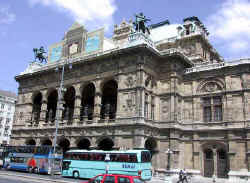 If
you do one thing in Vienna it should be to see the opera.
Ten USD gets you a balcony seat at the Staatsoper.
I luckily sat next to a woman who loves opera and knew the story of
Verdi’s Jerusalem. The plot line
is not so coherent, despite the foreign language performance, so without an
explanation I would have been totally lost.
I didn’t even realize it was in French until the second intermission.
The woman's mother, who must have been in her seventies offered her services as
a cook if she could come on my odyssey with me. While I am sure she is a
fantastic cook, I had to decline as being unable to afford her.
If
you do one thing in Vienna it should be to see the opera.
Ten USD gets you a balcony seat at the Staatsoper.
I luckily sat next to a woman who loves opera and knew the story of
Verdi’s Jerusalem. The plot line
is not so coherent, despite the foreign language performance, so without an
explanation I would have been totally lost.
I didn’t even realize it was in French until the second intermission.
The woman's mother, who must have been in her seventies offered her services as
a cook if she could come on my odyssey with me. While I am sure she is a
fantastic cook, I had to decline as being unable to afford her.
 Knowing
that I had a plane to catch in six days, and not in love with Vienna, I pushed on
to Salzburg, the next official stop on the backpacker slut tour and the home of
“The Sound of Music.” The hills
were alive with the sound of Pearl Jam when I arrived, since they were playing
in a square in the center of town. A
Canadian guy and I crossed the river to the old town center to hear what we
could from the outdoor venue. After
straining to hear what we could, security opened up the gates during the encores
and let in us freeloaders. I had
woken up that morning singing “Black,” and before I went to bed I heard
Eddie sing it himself, making my day.
Knowing
that I had a plane to catch in six days, and not in love with Vienna, I pushed on
to Salzburg, the next official stop on the backpacker slut tour and the home of
“The Sound of Music.” The hills
were alive with the sound of Pearl Jam when I arrived, since they were playing
in a square in the center of town. A
Canadian guy and I crossed the river to the old town center to hear what we
could from the outdoor venue. After
straining to hear what we could, security opened up the gates during the encores
and let in us freeloaders. I had
woken up that morning singing “Black,” and before I went to bed I heard
Eddie sing it himself, making my day.
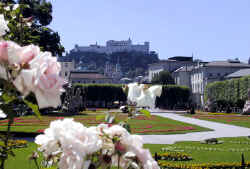 I
spent the next morning walking around Salzburg, stopping first at Schloss
Mirabelle—pretty gardens with a nice view of the fortress, called the Festung
Hohensalzburg, that dominates the city. Improved
upon over the centuries as new methods of attach made defenses obsolete, it has
ne
I
spent the next morning walking around Salzburg, stopping first at Schloss
Mirabelle—pretty gardens with a nice view of the fortress, called the Festung
Hohensalzburg, that dominates the city. Improved
upon over the centuries as new methods of attach made defenses obsolete, it has
ne ver
been taken by force. It stands
above the city and offers a spectacular 360-degree view of the city,
countryside, and the Alps from its towers.
ver
been taken by force. It stands
above the city and offers a spectacular 360-degree view of the city,
countryside, and the Alps from its towers.
My best meal in Salzburg was not the toffler-grostle in the
hostel (basically onions, potoatoes, ham/sausage/bacon, and basil and oregano)
but instead came from a restaurant called Naturesfreund on a wooded cliff
overlooking the city. It was great
food with a stunning sunset view, plus I fell in love with Anna from Hamburg who
shared a table with Ryan (an Aussie) and me.
It was the last I ever saw of her, and I left broken hearted.
I avoided the numerous Sound of Music tours.
After a few churches, two life size chess matches, and photos
galore, I left for Munich.
Knowing I had only two days before my flight and having
been to Munich once before, I deci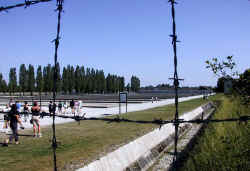 ded
to see the sights outside the city. With
limited time to plan, it seemed that organized tours were the best option.
The first was a trip to Dachau, a former concentration camp.
Unlike Auschewitz where the gates were locked the moment the last
prisoner left, Dachau served some post war functions and therefore has changed
somewhat. The execution wall was
re-plastered, and the barracks were all leveled for some health reasons.
Two barracks have been rebuilt to demonstrate the boarding conditions,
and several memorials have been erected within the gates.
ded
to see the sights outside the city. With
limited time to plan, it seemed that organized tours were the best option.
The first was a trip to Dachau, a former concentration camp.
Unlike Auschewitz where the gates were locked the moment the last
prisoner left, Dachau served some post war functions and therefore has changed
somewhat. The execution wall was
re-plastered, and the barracks were all leveled for some health reasons.
Two barracks have been rebuilt to demonstrate the boarding conditions,
and several memorials have been erected within the gates.
Dachau was not a death camp per se, though many died here.
It was the first concentration camp, so many of the first prisoners were
political opponents of the Third Reich. The
sadistic guards thought it amusing to have the prisoners who were men of the
cloth build the gas chamber. Researchers
believe it was never used, but it is chilling to enter and see showerheads
mounted in the ceiling to disguise the room’s purpose.
The camp’s outer wall was concrete six feet high with electrified
barbwire on top. Several feet
before was an electrified wire fence with a tangle of more electrified barbwire.
The ditch before you reached the fence was simply an obstacle to slow you
down, since by now you were in the kill zone demarked by the grass strip that
ran around the camp. If you were on the grass, guards would assume that you were
trying to escape and would shoot to kill. Occasionally
sadistic guards would throw a prisoner’s hat onto the grass—essentially a
death sentence. Prisoners would
sometimes run to the fence in order to commit suicide, an escape of sorts.
Despite the dec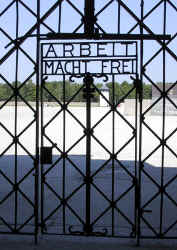 laration
on the one and only entrance to the camp of “Arbeit Macht Frei,” (Work Makes
Free), no prisoner was ever released for working hard.
If there was an escape, it was while a prisoner was outside of the camp
walls. No one ever made it over the
wall.
laration
on the one and only entrance to the camp of “Arbeit Macht Frei,” (Work Makes
Free), no prisoner was ever released for working hard.
If there was an escape, it was while a prisoner was outside of the camp
walls. No one ever made it over the
wall.
Typhus accounted for many deaths. Malnutrition plus inhumane living conditions caused the
disease to spread like wildfire through the camp.
Barracks intended for sixty something people held as many as 2000 at one
point. Prisoners slept packed like
sardines—so tightly that at 3 a.m. there was a wakeup call so everyone could
turn over. The healthier you were,
the higher you could climb up these triple-decker bunks. (Dachau was a camp for men only.) What level you slept on predicted how long you would live.
The healthiest at the top had a life expectancy of one month.
Those on the middle bunk were expected to live two weeks.
The weakest, on the bottom, were not expected to last the night.
What little prisoners heard of the war gave them hope for
it meant Hitler was still opposed. When
the Americans began to get close to Dachau, they learned of the situation.
They acted swiftly to prevent any more executions.
Approaching the camp, they came across boxcars full of bodies that had
not been disposed, which sickened them so much that they let some of the former
prisoners have their way with their former tormentors.
Some of this history was documented in the museum at the site, the
experience would not have been quite so moving (disturbing) were it not for the
excellent tour guide I had from Radius.
That night I headed for the Englisher Garden, a large park
designed by an Englishman. In the
middle is a tower called the Chineser Turm, around which is a massive beer
garden. On the walk to a second beer garden, the sun was beginning to set.
It soon turned into one of the most fantastic sunsets I have ever seen,
complete with fingers of light streaming from the clouds like some renaissance
painting. Both gardens were full of
people enjoying their massive liter glasses (appropriately called a “mass”),
and clutching huge pretzels. It was
quite a good way to end an otherwise assaulting day.
to a second beer garden, the sun was beginning to set.
It soon turned into one of the most fantastic sunsets I have ever seen,
complete with fingers of light streaming from the clouds like some renaissance
painting. Both gardens were full of
people enjoying their massive liter glasses (appropriately called a “mass”),
and clutching huge pretzels. It was
quite a good way to end an otherwise assaulting day.
The next morning I hopped on a bus for a very different
tour—“Mad” King Ludwig’s fairytale castles.
It is hard to write anything meaningful about this tour after the first
one, but I will try.
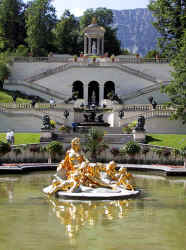 Ludwig
lived in the early to mid 1800’s. He
admired the French kings so much that he tried to model his lifestyle after
them. This meant building the most
opulent (and controversial) abodes you can imagine.
I saw two of the three on this trip.
The first, originally his father’s hunting lodge, was way over the top
with much homage paid to Louis XIV and XVI with busts of his two idols scattered
throughout the palace. Ornate
porcelain flower arrangements, gold trimmings, precious stones, et cetera,
covered every wall. Even the
gardens were immaculately groomed.
Ludwig
lived in the early to mid 1800’s. He
admired the French kings so much that he tried to model his lifestyle after
them. This meant building the most
opulent (and controversial) abodes you can imagine.
I saw two of the three on this trip.
The first, originally his father’s hunting lodge, was way over the top
with much homage paid to Louis XIV and XVI with busts of his two idols scattered
throughout the palace. Ornate
porcelain flower arrangements, gold trimmings, precious stones, et cetera,
covered every wall. Even the
gardens were immaculately groomed.
 The
second castle is the one that Disney brought to Florida.
Before it was finished, Ludwig lived in the second one for sixty days
before his family had him psychiatrically evaluated as unfit to rule, mostly
because of the exorbitant amounts of money he was putting into these
constructions. He was soon found
drowned with his psychiatrist in a lake near another residence.
Theories abound about what happened, but likely he vented his rage on his
shrink and then killed himself as well, for both were excellent swimmers.
The
second castle is the one that Disney brought to Florida.
Before it was finished, Ludwig lived in the second one for sixty days
before his family had him psychiatrically evaluated as unfit to rule, mostly
because of the exorbitant amounts of money he was putting into these
constructions. He was soon found
drowned with his psychiatrist in a lake near another residence.
Theories abound about what happened, but likely he vented his rage on his
shrink and then killed himself as well, for both were excellent swimmers.
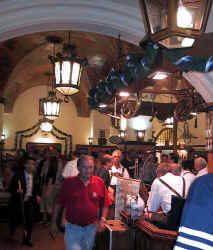 He
may have spent money lake a madman, but today people wonder how crazy he
actually was, for his palaces are the most touristed sites in Germany.
Perhaps he was just a genius ahead of his time?
He
may have spent money lake a madman, but today people wonder how crazy he
actually was, for his palaces are the most touristed sites in Germany.
Perhaps he was just a genius ahead of his time?
That
night I met up with an Aussie named Mark also on the tour.
We braved the Hofbrau House,
which seems to be even more of a frat party than it was seven years ago when I
was there last. It did at least
have an oompa-pa band and sweet flowing beer.
Still, it wasn’t quite my scene, so I headed to the huge Augustiner
Garten near my hostel for some hefeweitzen and pretzels before hitting the hay.
Munich is the beer capital of the world as Bavarians quaff 350 liters of
beer per person per year. I did my
best to help that average. It was a
good way to end the first leg of my trip as my next stop is
Sweden.
 Two
of my favorite moments in Vienna involved meals.
I stumbled across a fair in front of the of the Rathaus.
A beer (Gosser), a kielbasa, and oompa accordions made me feel like a
local for an hour or so. Later on
the advice of my guidebook I
Two
of my favorite moments in Vienna involved meals.
I stumbled across a fair in front of the of the Rathaus.
A beer (Gosser), a kielbasa, and oompa accordions made me feel like a
local for an hour or so. Later on
the advice of my guidebook I found my way to Grinzig to visit a Heurigan for dinner.
Joseph II allowed taverns to sell wine if they brewed it on the premises,
and Heurigans were born. Imagine a
beer garden with white wine and a hot and cold buffet inside.
The staff wears traditional Austrian dress, and there were a couple of
folk guitarists. Again it was easy
to imagine being there in another time.
found my way to Grinzig to visit a Heurigan for dinner.
Joseph II allowed taverns to sell wine if they brewed it on the premises,
and Heurigans were born. Imagine a
beer garden with white wine and a hot and cold buffet inside.
The staff wears traditional Austrian dress, and there were a couple of
folk guitarists. Again it was easy
to imagine being there in another time. 








